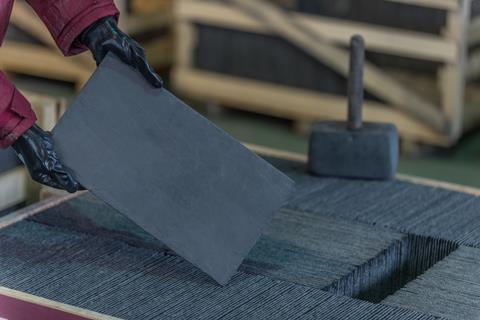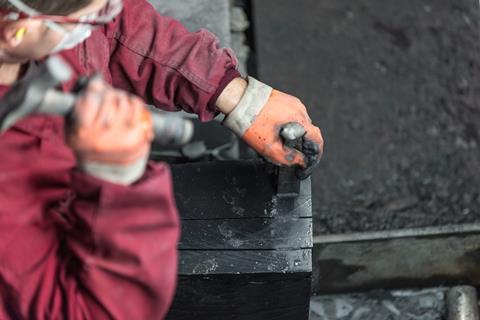This CPD, sponsored by Cupa Pizarras, examines the strengths of this ubiquitous material and its suitability for roofing and cladding purposes, as well as going through the steps that are needed to ensure quality is maintained from source to the end result.

CPD CREDITS: 60 MINUTES
DEADLINE: 8 NOVEMBER 2019
For more information about Assemble Media Group’s CPD distance-learning programme, click here


Introduction
Slate. A material familiar to many, its presence on roofs across the country mark it out as a much-loved addition to a home or municipal building. Whether mined or quarried, slate – essentially smooth, fine-grained metamorphic rock that can be split into layers – is natural, durable and waterproof. Environmentally friendly, slate is immune to chemical attack, it is resistant to acid rainfall and experiences low life cycle maintenance costs.
This CPD will examine the strengths of this ubiquitous material and its suitability for roofing and cladding purposes, as well as going through the steps that are needed to ensure quality is maintained from source to the end result.
Sourcing and quality
Generally slate is surface quarried but occasionally it is mined, where geological conditions make such activity preferable. As soon as the purity and viability of the slate composition has been ascertained, development of the site begins. Once earthworks and other initial tasks have been completed, the slate is extracted in large blocks in accordance with the techniques best suited to each quarry. The large blocks are sorted and laser sawn along their natural “cleavage” planes into smaller blocks. These blocks are then hand-split by skilled craftsmen into slates of the correct thickness.
The edges are dressed which means they are finished to give a natural chiselled look, which contributes to the overall effect when they are installed. They can also be pre-holed, if required, to minimise the risk of splitting when fixing.

Traceability
Quality is paramount. Checking at every stage in the production process is vital to the overall quality control. Some manufacturers employ a process of bar coding, which ensures superior traceability, enabling slate matching if additional slate is required for a particular project. Such barcodes contain the slate’s origin, type, dimensions and the results of tests to ascertain the required quality threshold.
The barcode also provides information about where and when the slate was processed and who worked on that particular batch.
Production standards
There are several international and national standards governing the quality and origination of slate. It is important that the slate being specified meets – or preferably exceeds – such standards in order to ensure the quality and longevity of the structure they are a part of.
In the UK under BS EN 12326-1:2014 a hundred samples are selected by the company commissioning the test.
Only the sample being tested is deemed to have complied with the quality standard achieved. Testing is carried out every two years unless production exceeds 12,000 tonnes, when it would be required to be conducted annually.

Installation and accompanying standards
Adherence to quality assurance procedures in the production of slate is vital. There are several national and international standards and accreditations governing the quality and origins of slate. It is important that the slate you specify meets or exceeds these in order to ensure the quality and longevity of the structure they form part of.
It is very important that roof coverings and cladding are fixed in accordance with British Standard for Slating and Tiling (BS 5534) to comply with new UK building regulations. Numerous important changes have been made, with the aim of improving roof security and structure.
The new standard for calculating fixing specifications for roof slates and slate cladding facades came into effect on 28th February 2015.
One of the most important changes is the mechanical fixing requirement of slates, increasing the safety on roofing and facade cladding. All slates must be mechanically fixed, installing dry ridge and hip systems. Mortar should be used in very traditional roofing and can be used in conjunction with mechanical fix options such as clips, nails or screws.
The British Standard BS 5534 identifies two installation methods: nailing and hook fixing. Slates are usually fixed to a batten in England and to a sarking board in areas of severe exposure throughout Scotland.
Pre-hold slates are a time efficient option for those who wish to use the nail fixing method. However, if on-site holing is required, you should choose the centre and head fixing, holing by hand or machine, one slate at a time. Additionally, slate nails should be either aluminium alloy or copper, or silicone bronze or stainless steel in coastal areas.
When opting for hook fixing method, it is important to know that hook fixings may not be suitable for large slates, which experience a greater wind uplift than smaller slates, and for pitches above 75º or below 25º. Slate hooks are available with straight or crimped shanks. However, crimped shanks reduce the capillary action and should be used for roof pitches below 30º. In addition, when fixing slates with hooks all perimeter slates should be nailed and hooked for health and safety reasons. Slate hooks should be stainless steel and be formed from stainless steel wire.
Hook fixing has a number of advantages, including reduced labour costs, fewer breakages or a simpler replacement process. This fixing method is very common in Europe, particularly in France and Belgium.
Once installed, natural roofing slate is subject to the forces of nature in which light, rain, ice, wind, hail, pollution and other atmospheric agents test its properties. It is vital that the slate quarried meets the rigours of these elements, so the whole production process has to be carefully managed and stringent quality control measures need to be in place.
It is important to understand the composition of natural slate in order to identify and differentiate between the high and low-grade variants of the material. Natural slate can have a widely varying chemical and mineral composition, which is determined by the geographical and geological characteristics of the quarry it was extracted from.
Certain constituents can also have an adverse effect on the appearance and integrity of natural slate over time.

The economics of using slate
The geographical and geological characteristics of the quarry the slate is extracted from will determine its composition and other characteristics, including its surface texture and appearance. Certain constituents such as iron or copper pyrites can have an adverse effect on the appearance and integrity of natural slate over time.
Any good roof covering should be maintenance-free. Natural slate is no exception as it does not require cleaning and ideally should be left alone. Foot traffic on a roof to carry out unnecessary cleaning is probably the most harmful thing that can happen to it, apart from storm damage. Re-usability is one area where natural slate out performs most clay roof coverings.
Generally a slate roof will last as long as the fixings which hold it in place. With a natural slate roof the same slates can be re-fixed onto new battens. Concrete tiles will have to be replaced with new and clay tiles will probably require substantial or complete replacement whether they be machine or hand made.
Cost comparisons look favourable for natural slate when you see what you get for your money. The cheapest and most versatile way of covering a pitched roof is with a concrete interlocking tile which can be used down to low pitches. However, concrete will lose its colour due to ultra violet light within a few years and will cease to be aesthetically pleasing as a result. Clay tiles weather considerably better but can be more expensive.
Natural slate performs to an incredibly high standard and the slates roofing materials can be reused on new battens. Natural slate is also lighter than other roofing slates such as concrete and as such battens don’t need reinforcement. There are special skills needed to work with slate, but many colleges are now running courses. Lack of traceability can be a disadvantage, which is why it is important to select slate from a company that can guarantee traceability on each batch of slate it supplies, so that replacement and matching do not become an issue.
There are a number of advantages and disadvantages which one should consider before using natural slate. On the plus side, natural slate has an aesthetic appeal and will stay looking good for many years. As such it may not need replacing. Other types of roofing slates such as concrete will lose colour and not wear so well visually, making slate more cost effective.
On the downside you are limited to naturally occurring shades of grey, so there will be some developments where it will not look right, but it does tend to complement most environments and does well in rural locations or heritage sites.
Responsible producers will supply a health and safety product data sheet relating to working with natural slate. This will cover all matters relevant to the prevention of accident or injury in the workplace.
In addition, there are health and safety regulations for pitched roofing, but these are general to all types of roofing material and not particular to natural slate. Scaffolding is essential for any work at height, but again nothing is different for fixing natural slate and the scaffolder is responsible for supplying, erecting and maintaining a safe environment for the roofing contractor.

Ventilation
Roof space ventilation is the most effective and economic method of keeping harmful condensation to a minimum, and it can be achieved by providing eaves through to the ridge ventilation.
Ventilation also depends on the construction method used; this can be ‘cold roof’ or ‘warm roof’. A warm roof has the insulation at rafter level, while a cold roof has insulation at the ceiling level.
It is important to consider a ventilator which enables ventilation or extraction through slate roofs. Good ventilation will help reduce costs and dangers attributed to winter weather. Even in summer, without proper ventilation, heat will rise and cause moisture to build up.
Impact of environment and site exposure
A building’s environment and the weather conditions to which it is exposed to are essential aspects when designing a roof. The design and technical details will not be the same for a project located in a sunny, dry region to a rainy region. The main factors to consider here are exposure to wind and rain.
The location is important as well, as it will impact the exposure. For example, buildings positioned on slopes, hills or coastal areas are classified as high exposure.
The type of slate used depends on the pitch of the roof. For example, small slates are more suitable for steep roofs with free-flowing drainage whereas larger slates are a better choice for lower roof pitches with more exposure.
In the UK, in southern England the most common slate size is 500mm x 250mm, while in the north of England and Scotland it is 400mm x 250mm.
The head lap – where the head of a slate is overlapped by the slate two courses above it –is calculated by measuring the roof pitch against the wind and rain exposure. The thickness of the slate should also be considered, as it reduces the pitch by 3º or more. For example, in lower pitches, the lap must be increased to help resist wind uplift and capillary action, especially if they’re highly exposed.
Slates should be laid with the thicker slates being installed at the eave. The slates should then be laid in diminishing thicknesses until the thinnest slates are at the top.

How to take this module
Assemble Media Group’s CPD distance-learning programme is open to anyone seeking to develop their knowledge and skills. Each module also offers members of professional institutions an opportunity to earn between 30 and 90 minutes of credits towards their annual CPD requirement.
This article is accredited by the CPD Certification Service. To earn CPD credits, read the article and then click the link below to complete your details and answer the questions. You will receive your results instantly, and if all the questions are correctly answered, you will be able to download your CPD certificate straight away.
CPD CREDITS: 60 MINUTES
DEADLINE: 8 NOVEMBER 2019
Privacy policy
Information you supply to Assemble Media Group Limited may be used for publication and also to provide you with information about our products or services in the form of direct marketing by email, telephone, fax or post. Information may also be made available to third parties. Assemble Media Group Limited may send updates about Building CPD and other relevant Assemble Media Group Limited products and services. By providing your email address you consent to being contact by email, telephone, fax or post by Assemble Media Group Limited or other third parties. If at any time you no longer wish to receive anything from Assemble Media Group Limited or to have your data made available to third parties, contact the Data Protection Coordinator at building@building.co.uk. View our full privacy policy here

















No comments yet